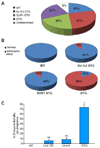Cardiac specific ATP-sensitive K+ channel (KATP) overexpression results in embryonic lethality
- PMID: 22796573
- PMCID: PMC3423334
- DOI: 10.1016/j.yjmcc.2012.07.001
Cardiac specific ATP-sensitive K+ channel (KATP) overexpression results in embryonic lethality
Abstract
Transgenic mice overexpressing SUR1 and gain of function Kir6.2[∆N30, K185Q] K(ATP) channel subunits, under cardiac α-myosin heavy chain (αMHC) promoter control, demonstrate arrhythmia susceptibility and premature death. Pregnant mice, crossed to carry double transgenic progeny, which harbor high levels of both overexpressed subunits, exhibit the most extreme phenotype and do not deliver any double transgenic pups. To explore the fetal lethality and embryonic phenotype that result from K(ATP) overexpression, wild type (WT) and K(ATP) overexpressing embryonic cardiomyocytes were isolated, cultured and voltage-clamped using whole cell and excised patch clamp techniques. Whole mount embryonic imaging, Hematoxylin and Eosin (H&E) and α smooth muscle actin (αSMA) immunostaining were used to assess anatomy, histology and cardiac development in K(ATP) overexpressing and WT embryos. Double transgenic embryos developed in utero heart failure and 100% embryonic lethality by 11.5 days post conception (dpc). K(ATP) currents were detectable in both WT and K(ATP)-overexpressing embryonic cardiomyocytes, starting at early stages of cardiac development (9.5 dpc). In contrast to adult cardiomyocytes, WT and K(ATP)-overexpressing embryonic cardiomyocytes exhibit basal and spontaneous K(ATP) current, implying that these channels may be open and active under physiological conditions. At 9.5 dpc, live double transgenic embryos demonstrated normal looping pattern, although all cardiac structures were collapsed, probably representing failed, non-contractile chambers. In conclusion, K(ATP) channels are present and active in embryonic myocytes, and overexpression causes in utero heart failure and results in embryonic lethality. These results suggest that the K(ATP) channel may have an important physiological role during early cardiac development.
Copyright © 2012 Elsevier Ltd. All rights reserved.
Figures





Similar articles
-
Arrhythmia susceptibility and premature death in transgenic mice overexpressing both SUR1 and Kir6.2[DeltaN30,K185Q] in the heart.Am J Physiol Heart Circ Physiol. 2007 Jul;293(1):H836-45. doi: 10.1152/ajpheart.00011.2007. Epub 2007 Apr 20. Am J Physiol Heart Circ Physiol. 2007. PMID: 17449558
-
Electrophysiological analyses of transgenic mice overexpressing KCNJ8 with S422L mutation in cardiomyocytes.J Pharmacol Sci. 2017 Sep;135(1):37-43. doi: 10.1016/j.jphs.2017.08.009. Epub 2017 Sep 6. J Pharmacol Sci. 2017. PMID: 28928055
-
Hypotension due to Kir6.1 gain-of-function in vascular smooth muscle.J Am Heart Assoc. 2013 Aug 23;2(4):e000365. doi: 10.1161/JAHA.113.000365. J Am Heart Assoc. 2013. PMID: 23974906 Free PMC article.
-
K(ATP) channel action in vascular tone regulation: from genetics to diseases.Sheng Li Xue Bao. 2012 Feb 25;64(1):1-13. Sheng Li Xue Bao. 2012. PMID: 22348955 Free PMC article. Review.
-
Measuring and evaluating the role of ATP-sensitive K+ channels in cardiac muscle.J Mol Cell Cardiol. 2012 Mar;52(3):596-607. doi: 10.1016/j.yjmcc.2011.12.012. Epub 2012 Jan 3. J Mol Cell Cardiol. 2012. PMID: 22245446 Free PMC article. Review.
Cited by
-
Heterogeneity and function of K(ATP) channels in canine hearts.Heart Rhythm. 2013 Oct;10(10):1576-83. doi: 10.1016/j.hrthm.2013.07.020. Epub 2013 Jul 17. Heart Rhythm. 2013. PMID: 23871704 Free PMC article.
-
Adenosine Triphosphate-Sensitive Potassium Currents in Heart Disease and Cardioprotection.Card Electrophysiol Clin. 2016 Jun;8(2):323-35. doi: 10.1016/j.ccep.2016.01.005. Epub 2016 Mar 19. Card Electrophysiol Clin. 2016. PMID: 27261824 Free PMC article. Review.
-
KATP Channels in the Cardiovascular System.Physiol Rev. 2016 Jan;96(1):177-252. doi: 10.1152/physrev.00003.2015. Physiol Rev. 2016. PMID: 26660852 Free PMC article. Review.
-
Control of the heart rate of rat embryos during the organogenic period.Hypoxia (Auckl). 2016 Nov 8;4:147-159. doi: 10.2147/HP.S115050. eCollection 2016. Hypoxia (Auckl). 2016. PMID: 27878135 Free PMC article.
-
KATP channels and cardiovascular disease: suddenly a syndrome.Circ Res. 2013 Mar 29;112(7):1059-72. doi: 10.1161/CIRCRESAHA.112.300514. Circ Res. 2013. PMID: 23538276 Free PMC article. Review.
References
-
- Zingman LV, Alekseev AE, Hodgson-Zingman DM, Terzic A. ATP-sensitive potassium channels: metabolic sensing and cardioprotection. J Appl Physiol. 2007 Nov;103(5):1888–1893. - PubMed
Publication types
MeSH terms
Substances
Grants and funding
LinkOut - more resources
Full Text Sources
Molecular Biology Databases

